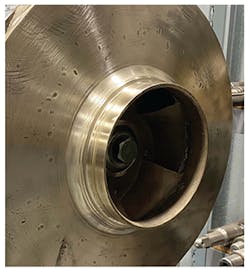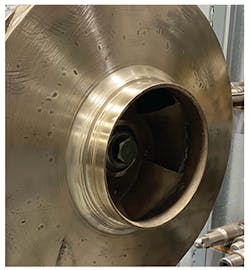In this article:
- What is cavitation?
- Why does this happen so often in centrifugal pumps?
- How do I know if I have cavitation occurring in my pump?
- How do I stop the cavitation?
Have you ever passed by a pump and heard what sounds like rocks or marbles going through it? Most likely, this noise is internal cavitation, one of the most common problems with pumps. Cavitation can cause loss of flow, higher energy usage, seal leakage, and internal metal damage.
What is cavitation?
Simply put, cavitation is the rapid formation and collapse of vapor bubbles within a liquid (see Figure 1).
As a liquid passes through a static pressure—which is lower than the liquid-vapor pressure—bubbles are formed. These bubbles can be up to 50,000 times larger than the original liquid size. As the bubbles move back to a static pressure higher than their liquid’s vapor pressure, they rapidly collapse or implode back to a liquid state.
This rapid collapse takes just a microsecond to happen, and the implosion creates a microjet and a shock wave during the collapse. If this implosion happens near a metal’s surface, the shock wave can loosen or damage the metal. Debris can then be washed away; this is called internal cavitation.
If these implosions and cavitation are allowed to continue, there will be additional loose areas and more metal loss. This can form pitting in the metal, or in some cases, it can resemble cheese with complete surfaces damaged.
These issues decrease pump efficiency—resulting in higher energy use, additional repair costs, and reduced pump lifespan.
Why does this happen so often in centrifugal pumps?
As the liquid enters the pump’s suction port, the impeller’s rotation creates a change in speed. Bernoulli’s principle states that as a liquid’s velocity increases, the static pressure decreases. In the case of cavitation, the liquid changes to bubbles. Now at some point, in the pump’s interior, the static pressure will go back up. This is when the implosion happens from the bubble collapsing back to liquid: cavitation.
Understanding the advantages of double-acting actuators
Back to basics: Fluid sealing school
How do I know if I have cavitation occurring in my pump?
In most cases, you can hear it. Listen for the sound of rocks or marbles inside the pump’s casing; it may help to use a stethoscope. Once you hear and identify cavitation, you will remember it. You can also see cavitation damage to your pump’s internal surfaces. In many cases, pitting can be seen on the impeller either at its eye (suction cavitation) or its tips (discharge cavitation).
How do I stop the cavitation?
There are several ways:
1. Remove blockages in the suction piping. They can be from filters, strainers, or partially closed valves. Remember that no blockages of any type should be in a pump’s suction line. A valve on the pump’s suction line should never be throttled.
2. Correct poor piping design. Before the pump’s suction port, there should be a straight run of piping that is 6 times the diameter of the pipe (e.g., a 2-inch diameter pipe would mean 12 inches of straight run). There should be no valves or fittings to obstruct flow. I have seen many pumps with a 90° elbow right at the suction port of a pump; this creates many issues. Also, watch for inverted U’s in the piping that can form air traps.
3. Most of all, if you believe you have a cavitation issue, have your application reviewed by a qualified liquid handling specialist. Your local vendor will have one of these specialists available. Remember, cavitation occurs because the inlet pressure is not high enough to maintain a static pressure higher than the vapor pressure of the liquid. The specialist will review the application to ensure that the pump’s inlet pressure (NPSHa, i.e., net positive suction head available) is higher than the inlet pressure required (NPSHr, i.e., net positive suction head required) by the pump manufacturer. To do so, they will look at the following:
- The suction piping: The liquid handling specialist will calculate the NPSHa. It is a great benefit if you (or the end user) have a compound gauge reading from the pump’s suction port. If no pressure reading is available, the specialist will review the piping.
- The discharge piping: The specialist will take a pressure reading at the pump’s discharge port. This will help identify the manufacturer NPSHr.
- The pump and motor identification: models, serial numbers, hp, and rpm.
- The pump curve: With all the above information, the specialist can reference the manufacturer’s pump curve to identify the gpm and check the NPSHr compared to the NPSHa of your process application. The specialist can then recommend any improvements to your application.
Installing a flow meter will also help your specialist evaluate your pump’s performance and can be valuable in identifying changes in your system. Listen to your pumps; make sure they don’t sound “rocky.” If you hear the sound, sooner is better than later to take action. Remember that a quiet pump is a happy, long-lived pump—resulting in less cost and less downtime for you.
This story originally appeared in the December 2021 issue of Plant Services. Subscribe to Plant Services here.
Based in the Midwest, Lon Boysen is a liquid handling product specialist for Motion. He has more than 18 years of industrial liquid handling experience, with the last 13 at Motion.


